WWII Imperial Japanese Navy Cruiser Mobile Pacific Fleet Man Overboard Signal
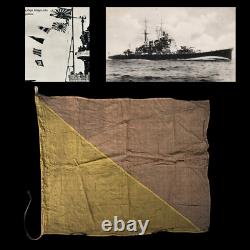
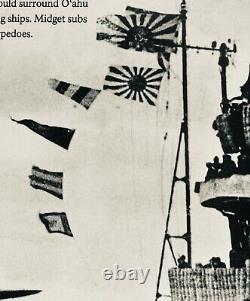
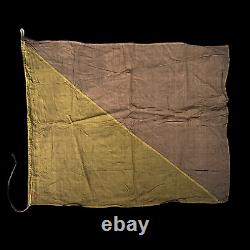
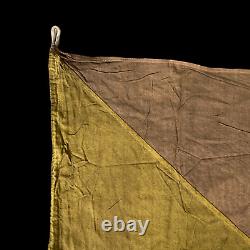
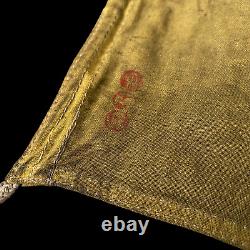
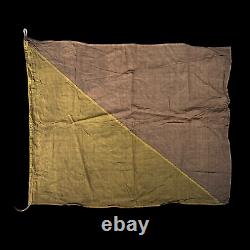
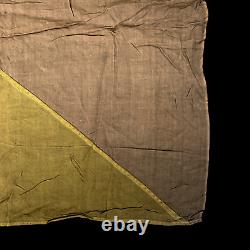
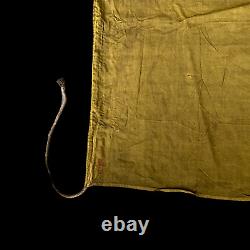
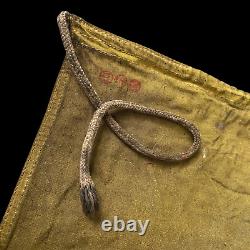
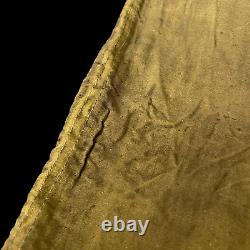
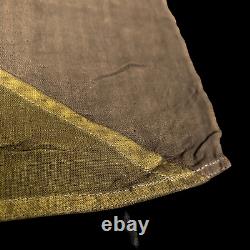
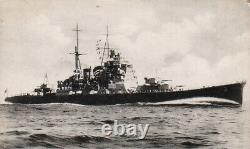


Size: 24 x 28 inches. While we do not know the name of the specific WWII Japanese cruiser this signal flag was taken off of, it is one of four obtained in the same bring back grouping with another signal flag being a specialized flag reserved exclusively for INJ Cruisers used to protect Japanese aircraft carriers.
This flag is the IJN Phonetic "Oba", Kana reading "Re". More notably this signal flag was used by the Imperial Japanese Naval to signal. This signal would be deployed in the accidental case a Japanese sailor fell overboard or recovering sailors and aviators in the water following a battle. The Imperial Japanese Navy in World War II, at the beginning of the Pacific War in December 1941, was the third most powerful navy in the world, and the naval air service was one of the most potent air forces in the world.
During the first six months of the war, the Imperial Japanese Navy enjoyed spectacular success inflicting heavy defeats on Allied forces, being undefeated in every battle. The attack on Pearl Harbor crippled the battleships of the US Pacific Fleet, while Allied navies were devastated during Japan's conquest of Southeast Asia. During 1943 the Allies were able to reorganize their forces and American industrial strength began to turn the tide of the war. American forces ultimately managed to gain the upper hand through a vastly greater industrial output and a modernization of its air and naval forces. In 1943, the Japanese also turned their attention to the defensive perimeters of their previous conquests.Forces on Japanese-held islands in Micronesia were to absorb and wear down an expected American counteroffensive. However, American industrial power became apparent and the military forces that faced the Japanese in 1943 were so overwhelming in firepower and equipment, that from the end of 1943 to 1944 Japan's defensive perimeter failed to hold. Defeat at the Philippine Sea was a disaster for Japanese naval airpower with American pilots terming it, the Great Marianas Turkey Shoot, while the battle of Leyte Gulf led to the destruction of a large part of the surface fleet. Consequently, the Japanese lost control of the Western Pacific. During the last phase of the war, the Japanese resorted to a series of desperate measures, including a variety of Special Attack Units which were popularly called kamikaze.
By May 1945, most of the Imperial Japanese Navy had been sunk and the remnants had taken refuge in Japan's harbors. By the end of the war, the IJN had lost 334 warships and 300,386 officers and men.
During WWII both the Allied and Axis Navys used signal flags, numeral pennants, numeral flags, and special flags and pennants for visual signaling. These signal flags are used to communicate while maintaining radio silence.
The Japanese Navy signal flags are a class of maritime signal flags for conveying messages in the Japanese language. The system generally uses the standard International Signal Flags, assigning both the letter, number, and repeater flags to various kana, roughly following Iroha order for the standard Letter Flags. The system also has several unique flags for some kana, as well as for conveying non-alphabetic messages. Like all navies, the Imperial Japanese Navy (IJN) used signal flags for all kinds of purposes, and like all navies, they used a mix of international flags and pennants, and special IJN flags and pennants.They divided their signal flags into two broad categories, which were, in turn further divided into five subsets. The first category was known as Letter or Number flags (Goki) and consisted of two subsets. Special Navy Number Flags (Sujiki): The Number Flag set consisted of ten navy special flags unique to the IJN that represented the numbers 0-9. International Letter Writing Flags (Mojiki): The International Roman alphabet (Romaji) flag set was the same set in use today. It consists(ed) of the 26 letters in the Roman alphabet.
The Letter or Number Flags (Goki) were used to make signals in coded letter/number groups, and set out numbers for course, bearing, distance, speed, and the like as commonly used in naval signaling. Most navies have an equivalent to the Navy Number Flags. The International Alphabet Flags were used in two ways generally. First, in combination with other flags or pennants they would indicate flag combinations in the signal book; for example Jin ZA; Naval Maneuver Pennant Jinkei=formation; Z=circular formation; A=formation A in Mobile Force Doctrine.Second was kana when the spelling of a word was required.


